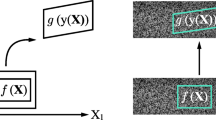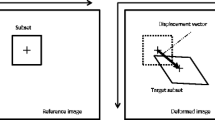Abstract
This article proposes a digital image correlation (DIC) method based on the stochastic parallel gradient descent (SPGD) algorithm. Stochastic parallel perturbations are imposed on deformation parameters to make the correlation coefficients converge to a global extremum; thus, this allows the final measured values of the deformation parameters to be obtained and the DIC measurement to be made. Both simulated and real data processing, including rigid body and strain deformation, show that the proposed method can achieve nearly the same accuracy as the Newton–Raphson (NR) method in most cases and higher accuracy in some cases, such as the simulated experiments of rigid body translation with and without noise. It also has a good noise-robustness. Furthermore, a series of experiments have been designed to evaluate the convergence characteristics of the proposed method, and it has been proved able to process large displacement and have a stable convergence process, good robustness, and a high convergence speed when bilinear interpolation is adopted.










Similar content being viewed by others
References
Yamaguchi I (1981) A laser-speckle strain gauge. J Phys E: Sci Instrum 14(1270):1273
Peters WH, Ranson WF (1982) Digital imaging technique in experimental stress analysis. Opt Eng 21(3):427–431
Ma SP, Jin GC (2003) New Correlation Coefficients Designed for Digital Speckle Correlation Method. Proc. SPIE 5058:25–33
Sutton MA (2008) Digital image correlation for shape and deformation measurements. In: Handbook of experimental solid mechanics. Springer, New York, pp 565–600
Sutton MA, Orteu J-J, Schreier HW (2009) Image correlation for shape, motion and deformation measurements: basic concepts, theory and applications. Springer, New York. doi:10.1007/978-0-387-78747-3
Chu TC, Ranson WF, Sutton MA, Peters WH (1985) Applications of digital image-correlation techniques to experimental mechanics. Exp Mech 25:232–244
Sutton MA, Cheng MQ, Peters WH, Chao YJ, McNeill SR (1986) Application of an optimized digital correlation method to planar deformation analysis. Image Vision Comput 4(3):143–150
Bruck HA, McNeill SR, Sutton MA, Peters WH III (1989) Digital image correlation using Newton–Raphson method of partial differential correction. Exp Mech 29:262–267
Cheng DJ, Chang FP, Tan YS, Don HS (1993) Digital speckle-displacement measurement using a complex spectrum method. Appl Optics 32(11):1839–1849
Ma SP, Jin GC (2003) Digital speckle correlation methodim proved by genetic algorithm. Acta Mech Solida Sin 16(4):366–373
Jin H, Bruck HA (2005) Theoretical development for pointwise digital image correlation. Opt Eng 44(6):067003
Sun Y, Pang JHL, Wong CK, Su F (2005) Finite element formulation for a digital image correlation method. Appl Optics 44(34):7357–7363
Vorontsov MA, Carhart GW, Ricklin JC (1997) Adaptive phase-distortion correction based on parallel gradient-descent optimization. Opt Lett 22(12):907–909
Vorontsov MA, Sivokon VP (1998) Stochastic parallel-gradient-descent technique for high-resolution wave-front phase-distortion correction. J Opt Soc Am A 15(10):2745–2758
Liu L, Vorontsov MA (2005) Phase-locking of tiled fiber array using SPGD feedback controller. In: Proc. SPIE. p 58950
Mathieu A, Vorontsov MA (2008) Imaging with an Array of Adaptive Subapertures. Opt Lett 33(1):10–12
Lachinova SL, Vorontsov MA (2008) Laser beam projection with adaptive array of fiber collimators. II. Analysis of atmospheric compensation efficiency. J Opt Soc Am A 25(8):1960–1973
Vorontsov MA, Lachinova SL (2008) Laser beam projection with adaptive array of fiber collimators. I. Basic considerations for analysis. J Opt Soc Am A 25(8):1949–1959
Zhou P, Ma Y, Wang X, Ma H, Xu X, Liu Z (2009) Coherent beam combination of three two-tone fiber amplifiers using stochastic parallel gradient descent algorithm. Opt Lett 34(2939):2941
Zhou P, Liu Z, Wang X, Ma Y, Ma H, Xu X (2009) Coherent beam combination of two-dimensional high power fiber amplifier array using stochastic parallel gradient descent algorithm. Appl Phys Lett 94:231106
Cauwenberghs GA (1993) Advances in neural information processing systems. Morgan Kaufman Publisher, San Mateo
Zhou P, Goodson KE (2001) Subpixel displacement and deformation gradient measurement using digital image/speckle correlation (DISC). Opt Eng 40(8):1613–1620
Huang YH, Liu L, Yeung TW, Hung YY (2009) Real time monitoring of clamping force of a bolted joint by use of automatic digital image correlation. Opt Laser Technol 41(4):408–414
Acknowledgments
This research was funded by the National Nature Science Foundation of China (Grant Nos. 40901215 and 11002156) and the Foundation of the National University of Defense Technology.
Sincere gratitude also goes to Dr. H. Y. Huang of Singapore-MIT Alliance for Research and Technology as the experimental data provider.
Author information
Authors and Affiliations
Corresponding author
Rights and permissions
About this article
Cite this article
Long, X., Fu, S., Qi, Z. et al. Digital Image Correlation Using Stochastic Parallel-Gradient-Descent Algorithm. Exp Mech 53, 571–578 (2013). https://doi.org/10.1007/s11340-012-9667-4
Received:
Accepted:
Published:
Issue Date:
DOI: https://doi.org/10.1007/s11340-012-9667-4




